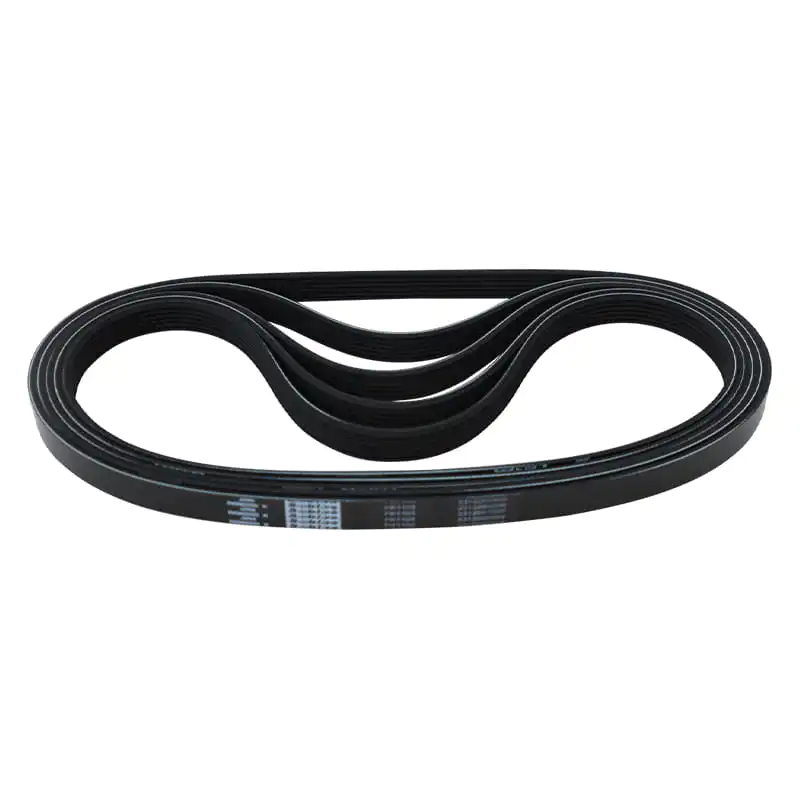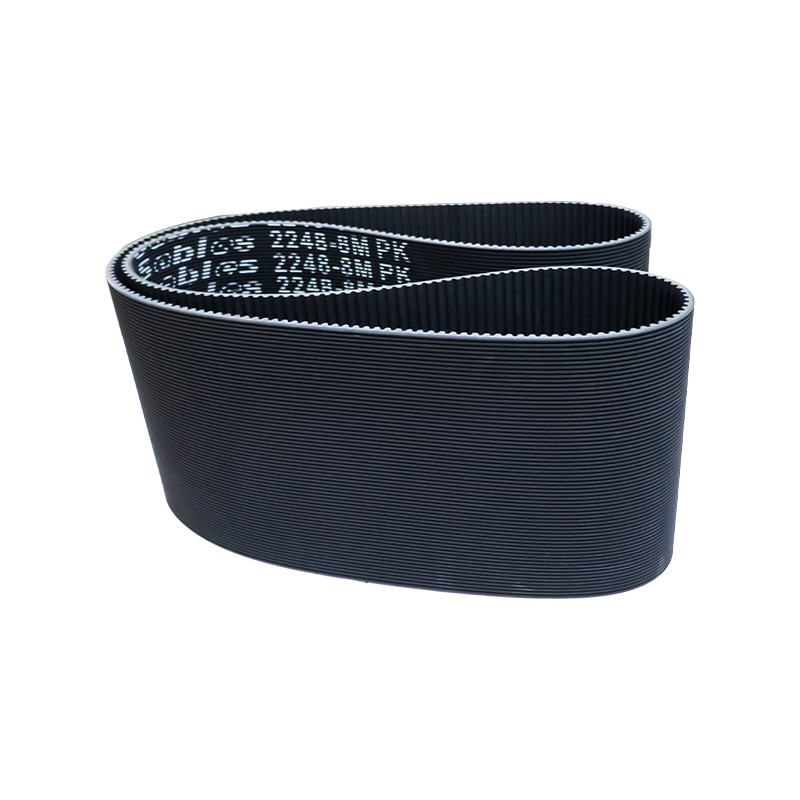Flat Belts are core power-transmission parts in industrial machinery, widely used in manufacturing, logistics, and mining to transfer torque between pulleys. Choosing suitable Flat Belts is vital for machinery efficiency—ill-matched Flat Belts cause frequent slippage, premature wear, and unexpected downtime. To avoid these issues, what 5 critical performance checks should you focus on when selecting Flat Belts for industrial use? This guide details each key step.
1. What Tensile Strength and Load Capacity Make Flat Belts Withstand Industrial Demands?
Tensile strength (the maximum force Flat Belts can bear without breaking) and load capacity (the maximum torque they can transmit) are fundamental for industrial application. Mismatched strength and load will lead to Flat Belts stretching, snapping, or failing:
Tensile Strength Matching: First, calculate the machinery’s maximum operating tension based on motor power, pulley diameter, and speed. Select Flat Belts with tensile strength 1.5–2 times the calculated tension . For example, if a conveyor system needs 600 N tension, choose Flat Belts with a minimum tensile strength of 900 N. Common materials vary in strength: polyester-cotton composite Flat Belts offer 15–25 MPa, while aramid-reinforced Flat Belts reach 30–40 MPa (ideal for heavy machinery like stone crushers).
Load Capacity Compatibility: Industrial machinery often handles variable loads (e.g., sudden start-ups or peak production). Flat Belts must tolerate these fluctuations without slipping. Look for Flat Belts labeled with “dynamic load rating” (the maximum load they can bear during transient peaks) . Avoid light-duty Flat Belts (e.g., rubber-only ones with weak reinforcement) in high-load machinery like printing presses—they stretch over time and need frequent retensioning.
Elongation Resistance: High-quality Flat Belts have low permanent elongation (≤2% after 100 hours of use) . Flat Belts with high elongation (such as unreinforced rubber ones) loosen quickly, requiring repeated adjustments and increasing pulley wear. For machinery with fixed center distances (no tension adjustment), prioritize low-elongation Flat Belts made of nylon or aramid.
2. How to Check Heat Resistance of Flat Belts for High-Temperature Machinery?
Many industrial processes (e.g., plastic extrusion, metal forging) expose Flat Belts to high temperatures (50°C–200°C). Poor heat resistance makes Flat Belts harden, crack, or melt, disrupting production. When evaluating Flat Belts, focus on these heat-related checks:
Maximum Operating Temperature Rating: Confirm the labeled maximum temperature of Flat Belts and ensure it exceeds the machinery’s average operating temperature by 10–20°C (as a safety buffer) . For instance, if a drying oven conveyor runs at 130°C, choose Flat Belts rated for 150°C or higher. Silicone-coated Flat Belts tolerate 150°C–200°C, while neoprene Flat Belts work best below 100°C.
Thermal Aging Resistance: Even within temperature limits, long-term heat exposure degrades Flat Belts. Ask manufacturers for “thermal aging test data”—high-quality Flat Belts retain ≥80% of their tensile strength after 1,000 hours at maximum temperature . Cheap rubber Flat Belts may lose 50% of strength in just 200 hours, leading to unexpected failures.
Heat Dissipation Ability: Flat Belts that trap heat accelerate self-degradation. Choose Flat Belts with textured surfaces or breathable materials (e.g., woven polyester Flat Belts) to promote heat dissipation . In machinery with tight pulley spacing (where Flat Belts generate friction heat), avoid solid rubber Flat Belts—they retain heat and wear faster.
3. What Friction and Slip Resistance Features Ensure Flat Belts Are Reliable?
Industrial machinery relies on Flat Belts to transmit power without slippage (slippage reduces efficiency and damages pulleys). To ensure reliable friction, check these features of Flat Belts:
Coefficient of Friction (COF): The COF between Flat Belts and pulleys determines grip. For dry environments (e.g., textile machinery), select Flat Belts with a COF ≥0.4 (like rubber-coated ones). For oily or dusty environments (e.g., automotive assembly lines), choose oil-resistant Flat Belts with a high-traction surface (e.g., diamond-patterned neoprene Flat Belts) to maintain a COF ≥0.3.
Surface Material Durability: Friction wears down Flat Belts’ surfaces over time—low-quality Flat Belts develop smooth spots (reducing grip) after a few weeks. Prioritize Flat Belts with wear-resistant surface layers, such as polyurethane-coated Flat Belts (which retain texture for 6–12 months) or rubber Flat Belts with carbon black additives (enhancing abrasion resistance).
Tension Retention: Even with high friction, Flat Belts that lose tension slip. As mentioned earlier, low-elongation materials (nylon, aramid) help Flat Belts maintain tension. Additionally, some Flat Belts have built-in tension members (e.g., steel cords) to prevent stretching—ideal for machinery with long Flat Belts spans (like warehouse conveyors).
4. How to Evaluate Chemical Resistance of Flat Belts for Corrosive Environments?
Industrial machinery in chemical plants, food processing, or cleaning sectors exposes Flat Belts to corrosive substances (acids, oils, detergents). Unresistant Flat Belts swell, disintegrate, or leach harmful particles. Conduct these chemical checks for Flat Belts:
Material Compatibility: Match Flat Belts to the chemicals they contact. For acidic environments (e.g., battery manufacturing), use fluoropolymer-coated Flat Belts (resistant to sulfuric and hydrochloric acids). For oily machinery (e.g., engine assembly), neoprene or nitrile Flat Belts are oil-resistant and won’t degrade. Avoid natural rubber Flat Belts in any chemical environment—they swell in oils and dissolve in acids.
Food-Grade Compliance (for Food Processing): If Flat Belts contact food (e.g., bakery conveyors), they must be FDA-approved and resistant to cleaning chemicals (e.g., sodium hypochlorite). Choose polyurethane or silicone Flat Belts labeled “food-grade”—they won’t absorb detergents or leach toxins into food.
Chemical Aging Testing: Ask manufacturers for test results showing how Flat Belts perform after exposure to target chemicals. A good chemical-resistant Flat Belts retains ≥90% of its strength after 500 hours of immersion in the relevant chemical . Poorly resistant Flat Belts may lose strength or change shape in just 100 hours.
5. What Dimensional Accuracy and Fit Ensure Flat Belts Work with Machinery?
Even high-performance Flat Belts fail if they don’t fit the machinery’s pulleys and spacing. Dimensional checks are critical to avoid installation issues and premature wear of Flat Belts:
Width and Thickness Tolerance: Industrial pulleys have precise groove sizes—Flat Belts must match these dimensions within ±0.5mm . A Flat Belts that’s too wide rubs against pulley flanges (causing edge wear), while one that’s too thin slips. For example, if a pulley requires a 25mm-wide Flat Belts, choose one with a width of 24.5–25.5mm.
Length Precision: Incorrect Flat Belts length leads to improper tension (too short = excessive tension, too long = slippage). Measure the machinery’s Flat Belts path (pulley diameters + center distance) and select Flat Belts with a length tolerance of ±1% . For custom machinery, opt for made-to-order Flat Belts (instead of standard lengths) for a perfect fit.
Flatness: Warped or uneven Flat Belts don’t contact pulleys uniformly, causing uneven wear and vibration. Inspect Flat Belts visually—high-quality ones lie flat on a surface without curling or twisting. Avoid Flat Belts with bubbles or wrinkles (signs of poor manufacturing).
Bonus: What Additional Factors Complement These Checks for Flat Belts?
Beyond the 5 critical checks, consider these to finalize Flat Belts selection:
Machinery Speed: High-speed machinery (≥1,500 RPM) needs Flat Belts with low mass (e.g., lightweight polyester Flat Belts) to reduce centrifugal force (which can make Flat Belts lift off pulleys).
Environmental Conditions: For dusty environments (e.g., mining), choose antistatic Flat Belts (to prevent dust buildup and static sparks). For outdoor use, UV-resistant Flat Belts (e.g., EPDM Flat Belts) avoid sunlight-induced degradation.
Manufacturer Support: Select brands providing technical data sheets (proving Flat Belts’ tensile strength, heat resistance, etc.) and a 6–12 month warranty. Avoid unbranded Flat Belts—they lack performance validation and replacement support.














